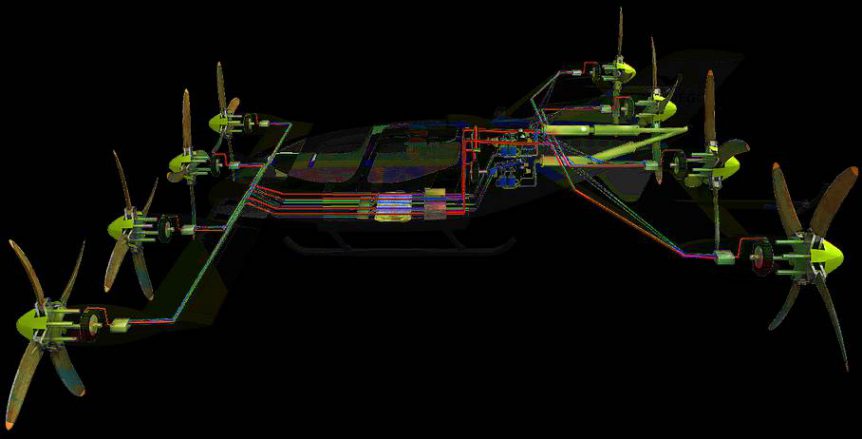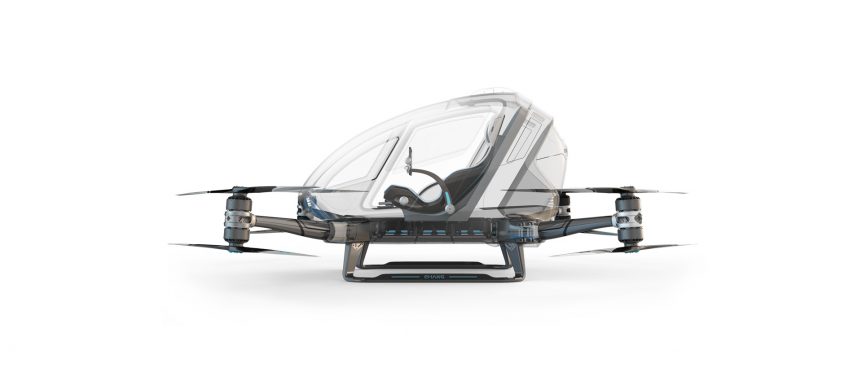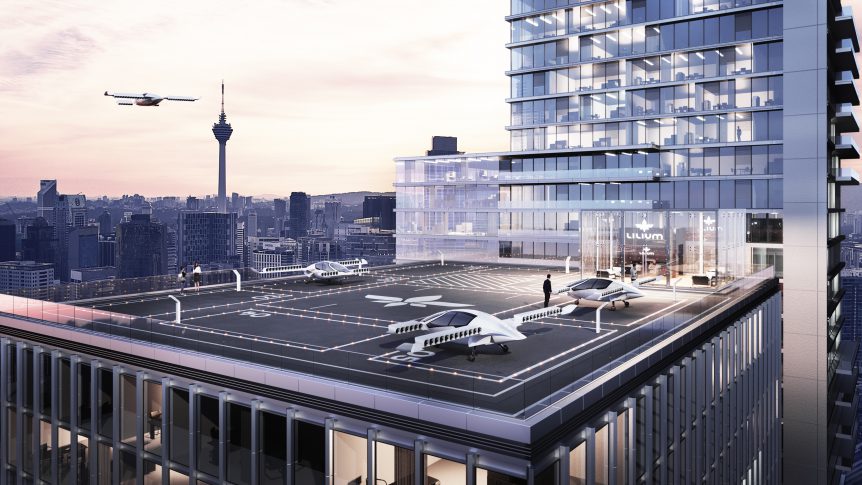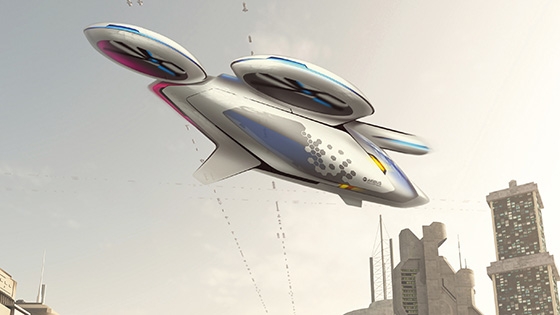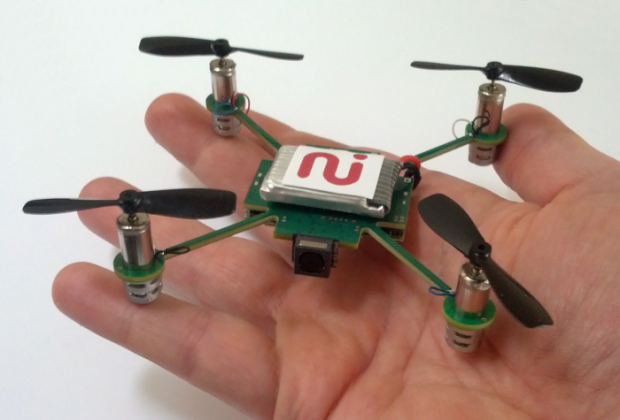Erik Lindbergh, grandson of the famed trans-Atlantic flight pioneer, has been paying his dues in aviation for decades, working to involve young people in career-building roles, and advocating for “green” aviation. His latest roles have found him mentoring a group of Embry Riddle students in developing an electric HK-36 (shown last year at AirVenture), and in developing one of the over 100 electric vertical takeoff and landing (eVTOL) potential sky taxis coming into public view. That sky taxi may not make it to market, but Lindbergh and partners’ Integrated Distributed Power system is headed that way. At the 2017 AirVenture, he shared the news that he was working on something exciting. That turned out to be the VerdeGo project, an eight-rotor eVTOL which he developed with co-founder Eric Bartsch and Embry Riddle Director of the Eagle Flight Research Center and Green Flight Challenge competitor Dr. Pat Anderson. Eric is Chief Operating Officer for VerdeGo and Pat is Chief Technology Officer. …
Vahana Flies! Another Competitor in the Sky Taxi Airspace
Zach Lovering, Project Executive for Airbus subsidiary A3 reports, “Today marks a historic day for Airbus, A³, and the Vahana team. We can now announce our successful first flight. At 8:52AM on January 31, 2018 in Pendleton, Oregon, our full-scale aircraft, dubbed Alpha One, reached a height of 5 meters (16 feet) before descending safely. Its first flight, with a duration of 53 seconds, was fully self-piloted and the vehicle completed a second flight the following day. In attendance was the full Vahana team, representatives from the FAA, and A³ leadership, all coming together to witness this historic accomplishment.” Hovering Autonomously With canards built in Portland, Oregon at Flighthouse Engineering LLC, the tandem-winged, eight-rotor, 745 kilogram (1,642 pound) machine has a wingspan, or width, of 6.2 meters (20.3 feet), a length of 5.7 meters (18.7 feet) and a height of 2.8 meters (9.2 feet). Vahana is one of two Airbus VTOL urban transport options, the Pop.Up design combining ground and …
Too Late for Boxing Day*, Ehang Delivers the Goods
Broadcast live on December 24, this demonstration of the eHang 184 is, interestingly, an English-language presentation, with a lot of English names floating about. Someone named Mike shows off the Ehang 184 in this Christmas-related special. His friend Miranda snugs herself into the compact passenger compartment, tries on the safety harnesses, and deplanes before committing aviation. The video is a sales pitch for the drone manufacturer – actually more of a long wind-up before a pitch into the air. Mike takes us through a tutorial on the craft, which seats one passenger and has eight propellers that are mounted on four arms (one-eight-four, or 184). The rather ungainly entrance and exit of the petite young woman suggests possible improvements eHang’s designers might make in the otherwise swoopy-looking gull-wing doors. They might also consider how to protect the unwary from the knee- and ankle-high 1.6 meter (5.25 feet) propellers. One hopes the designers have incorporated a safety propeller stop system such as …
Lilium Flies a Quick Demonstration
Lilium, a 36-motor electric VTOL aircraft, made initial test flights near Munich, Germany.
Airbus’s Aerial Commuter of the Future?
Airbus and its partner Local Motors have just finished a successful design challenge for delivery drones that can carry things like emergency medical supplies to selected destinations. Recent announcements and the release of a patent drawing show Airbus is doing serious work toward delivering humans to their selected destinations in a scaled-up version of such drones. Many brilliant people have tried to combine the benefits of ground and air transport over the years, including Molt Taylor, designer of the rightly famous Aerocars. The example at Seattle’s Museum of Flight causes docents to lower their voices out of respect for the accomplishment. That’s certainly a concept promoted for last decade by Dr. Brien Seeley, head of the Sustainable Aviation Foundation and sponsor for this blog. His AIAA paper on Regional Sky Taxis spells out his hopes for alleviating ground-bound gridlock with aerial alternatives. Recently, Airbus formed a group in California’s Silicon Valley called A3, or A Cubed. The group earned a …
Why It Might Be a Good Idea to Register Drones
At some point in the not-too-distant future, all those Christmas-gift quadrotors and Star Wars replica drones will be joined by medium-size burger bombers and two-hour-guaranteed delivery aerial vehicles for fast food restaurants and on-line retailers sending their wares to a landing zone near your front door, or perhaps the roof of your apartment. This probably isn’t what Alfred Lord Tennyson had in mind when he wrote: ” For I dipt into the future, far as human eye could see, Saw the Vision of the world, and all the wonder that would be; “Saw the heavens fill with commerce, argosies of magic sails, Pilots of the purple twilight dropping down with costly bales;” (From Locksley Hall, 1835) There are already rules governing drone flight, but no tests for competence of pilots, who will be often untrained, unaware, or uncaring. For larger drones and commercial flights, we can probably expect stringent rules, but for the growing number of amateurs unaware of the …
EAS IX: David Calley’s Innovative Design and Use of Electric Motors
David Calley is member of the CAFE Foundation Advisory Board, with a great deal of technical expertise to offer. His small wind turbine sold over 150,000 units. His patented design for the TrailerTail® increases fuel economy on semi-trucks and trailers by 5.4 percent at 65 miles per hour, according to SAE tests. Last year at EAS VIII, he showed the potential for small motors with incredible torque that could power Sky Taxis. At this year’s EAS IX he described, in depth, the type of motor design he has been developing to power things like his three-wheel electric/pedal-powered commuter vehicle and landing-gear wheels on Sky Taxis and even rocket fuel pumps. He asked the not-too-rhetorical questions, “How high can electric motor power go?” and “Where do these forces come from?” His answers took attendees on a high-level look at electromagnetic and permanent magnet (PM) materials theories. Electric motors rely on interactions between fields to produce power. “Fields” in this case are …
A Lighter, Zippier Tire for Electric Airplanes?
Tires are not usually the first thing that comes to mind when thinking of airplane design. On most aircraft, the landing gear is an awkward necessity, something to help one get airborne and settle on after committing aviation. Our future electric aircraft might have power-driven wheels to shorten takeoff and landing distances, making them less inconvenient and more beneficial. Conventional rubber tires and wheels are heavy, though, and reducing their avoirdupois would enable better performance from a lighter airplane, or allow more batteries for longer range or better performance. Dr. Brien Seeley, founder and President of the CAFE Foundation, wants to visit the best of all possible tire worlds by exploring the potential of polyurethane tires, reducing the need for rubber-based tires along with eliminating the use of fossil fuels. Polyurethane tires have some advantages worth exploring, while we maintain some objectivity about the reasons we don’t see more of them on our cars, for instance. Rubber tires are weighty …
EAS IX: JoeBen Pulls off a Hat Trick
JoeBen Bevirt, founder and head of Joby Aviation and Joby Motors , is obviously a workaholic, and not only gave a talk at EAS IX, but had an example of his Lotus unpiloted aerial vehicle at the AUVSI (Association for Unmanned Vehicle Systems International) conference in Atlanta, Georgia on the same weekend. Two weeks before that, his demonstration wing for the LEAPTech program was speeding across the desert at NASA’s Armstrong Flight Research Center (AFRC), Edwards Air Force Base in California. JoeBen told Symposium attendees all about his S2 personal aerial commuter and LEAPTech, a joint development with NASA. Part of the LEAPTech program has included building a truck platform for testing the 18-motor wing. This is a fascinating bit of engineering in itself. YouTube does not yet show a test run with the truck and wing, but this news item includes it here. LEAPTech (Leading Edge Asynchronous Propeller Technology) is a NASA Team Seedling Award under the Convergent Aeronautics Project of …
EAS VIII: Making Small Airplanes Ride Smoothly
Dr. C. P. (Case) van Dam of the University of California at Davis provided some counter-intuitive pointers on making small airplanes ride more smoothly to participants at the eighth annual Electric Aircraft Symposium in late April. His solutions for ride quality enhancement in small airplanes are an essential ingredient in making electric Sky Taxis a plausible reality. Because at least initially many electric aircraft are constrained to long wing spans and light wing loadings, they are subject to “perturbations of significant magnitude to be unacceptable.” These disruptions of the intended altitude and direction of the aircraft can be more upsetting to passengers than to the aircraft itself, but van Dam had several suggestions to alleviate the vertical and lateral accelerations that passengers perceive as bumpy air. He had explained the possible need for a gust alleviation system in his 2008 Electric Aircraft Symposium talk, something he felt even then would be necessary, “In order for these vehicles to achieve acceptable …

